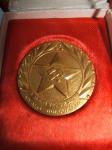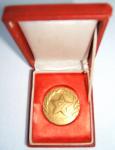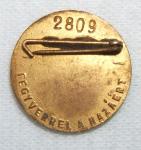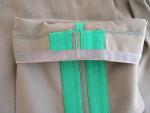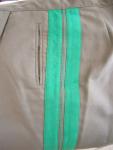-
Posts
4,725 -
Joined
-
Last visited
-
Days Won
7
Content Type
Profiles
Forums
Blogs
Gallery
Events
Store
Everything posted by Gordon Craig
-

Hungary Hungarian Kivalo Dolgozol Badges
Gordon Craig replied to hunyadi's topic in Central & Eastern European States
Zsolt, Thanks for posting this very interesting info. The list of medals to look for keeps growing thanks to your sharing your knowledge. Looking at the last three awards you posted. Post #127 award has the lettering KIV?LŐ BANYSZ and post #129 has the lettering A BANYASZ KIV?LŐ DOLGOZJA. Since you say both these awards were made from June 1954 to 1977 it looks to me as if there may have been four badges during this time frame with the same wording as you list for my 1954 type award. True? Interesting to know that the 1954 to 1977 awards with different wording were also a different design. Cheers, Gordon -
Charles, Thanks for making sense out of these medals for me. Didn't make sense that the older medals would be the easiest to find. Since the large medals book doesn't show the backs of the medals I didn't realize there were two sets that looked the same. I need to add this to this to the info in my files on the Large Medals book. Regards, Gordon
-

DDR My DDR Police Collection
Gordon Craig replied to Hauptmann's topic in Germany: Post 1945: Bundesrepublik & DDR
Dan, There are lots of blank ones available on ebay.de but not many completed ones show up for sale. I don't think there was a lot of stigmatism associated with being a police helper. It is a long standing German tradition and not the same as being an informant for the STASI. Those people had a hard time after the wall fell and the files were opened. For example, the only East German fighter airplane accepted into the West German Luftwaffe, after the reunification of the forces, was the MiG 29. The Luftstreitcraft squadron pilots that flew the MiG 29 were offered positions in the Bundesluftwaffe and amost all of them accepted. After the STASI files were opened and researched it turned out that some of the East German MiG 29 pilots had been informers and seven of them "resigned" their commissions in the Bundesluftwaffe immediately. Regards, Gordon -
Order of Victory, Charles has beaten me to the answer and has done a better job than I as I don't have all of the 1964 medals. Strangely enough, the 1964 type of medal is more available than the 1965 or the 1983 ones. Perhaps that is a task for me to concentrate on today. Seeing just what I have in the 1964 medals so I can list what I need to look for at the Flea Markets this weekend. Regards, Gordon
-

Hungary Hungarian Kivalo Dolgozol Badges
Gordon Craig replied to hunyadi's topic in Central & Eastern European States
Zsolt, Thanks for the info. Very impressive badge you posted. Now I have another on to look for to go with my Miners tunic. Regards, Gordon -

Hungary Hungarian Kivalo Dolgozol Badges
Gordon Craig replied to hunyadi's topic in Central & Eastern European States
Here is another Kivalo badge I picked up recently. I have found a couple of translations for KIOSZ on the net. They are: Kisiparosok Orsz?gos Sz?vets?ge (KIOSZ) #1-The National Organization of Crafstmen or #2 The National Association of Small Manufacturers. I think #1 is the most logical. From the figure III on the badge it would seem that there were three different awards in this series. Regards, Gordon -

Hungary Hungarian Kivalo Dolgozol Badges
Gordon Craig replied to hunyadi's topic in Central & Eastern European States
Zsolt, Thanks for the info. I have Charles to thank for this cased medal. We were in a store going through a box of stuff and I asked him if he knew what a Miners Kivalo looked like. He said he had just seen one and pulled it out of the box for me. If I understand your post correctly, this badge was only awarded for about a year. True? Do you have a picture of the award presented after this one was no longer awarded/ Regards, Gordon -
Having started you down this path I should have responded sooner. Very close on the Swallows Nests. The white was worn by members of the NVA Orchestrer, Musikkorps and Spielmannszuge. Green could be for either polizei or Border Guard. I am taking a guess here but the green looks too light for Border Guard. I would be more inclined to say it was for polizei. If it is for polizei the fringed ones woul be worn by Wchtmeisterdienstgrade des zentralen Orchesters der MdI and Leiter der Spielmannszuge (im Dienstgrad Unterleutnant bis Hauptmann) in den VP-Bereitschaften. On to the shoulder board. Not STASI. Could be either Reichsbahn or Post but I haven't taken the time to look through my reference material to identify it but probably Reichsbahn. Cheers, Gordon
-

DDR My DDR Police Collection
Gordon Craig replied to Hauptmann's topic in Germany: Post 1945: Bundesrepublik & DDR
Dan, Interesting document. Thanks for posting the additional pages. Regards, Gordon -

Hungary Hungarian Kivalo Dolgozol Badges
Gordon Craig replied to hunyadi's topic in Central & Eastern European States
-

Hungary Hungarian Kivalo Dolgozol Badges
Gordon Craig replied to hunyadi's topic in Central & Eastern European States
-

Hungary Hungarian Kivalo Dolgozol Badges
Gordon Craig replied to hunyadi's topic in Central & Eastern European States
-

Hungary Hungarian Kivalo Dolgozol Badges
Gordon Craig replied to hunyadi's topic in Central & Eastern European States
-

Hungary Hungarian Kivalo Dolgozol Badges
Gordon Craig replied to hunyadi's topic in Central & Eastern European States
Here is a rare one I picked up yesterday. A B?NY?SZAT KIV?L? DOLG0Z?JA for a miner. Nice to have a rare badge in a case. Not so nice to have pay the price these things are worth! Regards, Gordon -

Hungary Hungarian Partisan History and Research
Gordon Craig replied to hunyadi's topic in Central & Eastern European States
-

Hungary Hungarian Partisan History and Research
Gordon Craig replied to hunyadi's topic in Central & Eastern European States
In the interest of pure research I am going to post pictures of two numbered miniature Partizan Bdges that I have. The early one, number 490 is numbered on the bottom. The later one, number 2809, is numbered at the top. Idle curiosity urges me to ask, "Did they stop numbering the badges at the bottom and start numbering them at the top at a certain time and then stay with the numbers at the top or did they get numbered in either location at the whim of the person doing the numbering?". Regards, Gordon -

Hungary Hungarian Firemen's Medals
Gordon Craig replied to Gordon Craig's topic in Central & Eastern European States
Zsolt, Sorry but I do not have a medal to trade. I was waiting to receive another 30 year Bronze 1974 Fireman's medal and not sure if it was for a Volunteer Fireman or a Professional Fireman. Turns out it was the one I do not have so I will be keeping boh of them. Regards, Gordon





